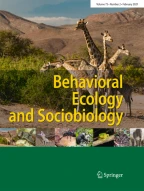Summary
Acorn woodpeckers (Melanerpes formicivorus) were studied during the summers of 1976 and 1977 in the Chiricahua Mountains of Arizona to determine the ecological correlates of variations in unit size, storage behavior, and home range. Unit size varied from two to five adults, acorn storage capacity varied from 0 to 5,000 individual holes per unit, and home range size varied from 5.2 to 51.2 ha.
There was a consistent but nonsignificant trend for units inhabiting pine-oak woodland to be larger and to maintain more food storage holes than units in oak-juniper or oak woodland. Pine-oak woodland had the highest oak species number, density, and basal area of any community in the study area, and showed the least annual variation in percent of oaks producing acorns during the study. However, pineoak woodland also had the lowest acorn productivity per hectare.
More than four times as many oak trees produced acorns in 1977 than in 1976. Following the poor 1976 crop, unit home range size increased so that the mean number of oaks contained per home range size increased more than three and a half times in 1977. The number of woodpecker units containing nonbreeding adults decreased from 90% in 1976 to 20% in 1977. These data suggest that the size and reliability of acorn crops control the composition of acorn woodpecker social units.
A comparison of acorn woodpecker population parameters in the Chiricahua Mountains and at the Hastings Reservation, California, was made, using data of MacRoberts and MacRoberts (1976). The California population was significantly more dense and maintained more storage trees and more individual storage holes per unit, but there was no evidence that more California units contained nonbreeding adults than did Chiricahua units.
A model is presented that emphasizes the importance of acorn crop reliability as the major determinant of acorn woodpecker social organization (Fig. 2). Annual crop fluctuations affect the winter survival and dispersion of woodpecker units, and the density of the population in the following spring. Bad acorn years will result in decreased saturation of woodpecker nesting habitat by established groups. The model predicts a corresponding decrease in the frequency of units with helpers, as young adults take advantage of opportunities to breed on their own. Longer-term crop reliability determines the benefitcost ratio for establishing and maintaining food storage facilities. The observed geographic variation in storage behavior between California and Arizona populations is suggested to reflect differences in the long-term return on investment in expensive storage facilities.
Similar content being viewed by others
References
Balda RP (1967) Ecological relationships of the breeding birds of the Chiricahua Mountains, Arizona. PhD dissertation, University of Illinois, Urbana, Illinois
Balda RP (1969) Foliage use by birds of the oak-juniper woodland and ponderosa pine forest in southeastern Arizona. Condor 71:399–412
Bock CE, Bock JH (1974) Geographical ecology of the acorn woodpecker: diversity versus abundance of resources. Am Nat 108:694–698
Bonham CD (1972) Ecological inventory and data storage-retrieval system for the Research Ranch, Elgin, Arizona. Col State Univ Range Sci Dep Sci Ser 14:1–93
Brown JL (1969) Territorial behavior and population regulation in birds. Wilson Bull 81:293–329
Brown JL (1978) Avian communal breeding systems. Annu Rev Ecol Syst 9:123–155
Brown JL, Balda RP (1977) The relationship of habitat quality to group size in Hall's babbler (Pomatostomus halli). Condor 79:312–320
Downs AA, McQuilken WE (1944) Seed production of southern Appalachian oaks. J For 42:913–920
Gaston AJ (1977) Social behavior within groups of jungle babblers (Turdoides striatus). Anim Behav 25:828–848
Gaston AJ (1978) Demography of the jungle babbler, Turdoides striatus. J Anim Ecol 47:845–870
Gaston AJ, Perrins CM (1975) The relation of habitat to size of group in the genus Turdoides. EMU 74 (Suppl.):309
Goodrum PD, Reid VH, Boyd CE (1971) Acorn yields, characteristics, and management criteria of oaks for wildlife. J Wild Manage 35:520–532
Griffin JR (1971) Oak regeneration in the uper Carmel Valley, California. Ecology 52:862–868
Griffin JR (1971) Regeneration of Quercus lobata savannas, Santa Lucia Mountains, California. Am Midl Nat 95:422–435
Gutiérrez RJ, Koenig WD (1978) Characteristics of storage trees used by acorn woodpeckers in two California woodlands. J For 76:162–164
Hastings JR, Turner RM (1965) The changing mile. University of Arizona Press, Tucson
Koenig WD, Williams PL (1979) Notes on the status of acorn woodpeckers in central Mexico. Condor 81:317–318
MacRoberts MH (1970) Notes on the food habits and food defense of the acorn woodpecker. Condor 72:196–204
MacRoberts MH, MacRoberts BR (1976) Social organization and behavior of the acorn woodpecker in central coastal California. Omithol Monogr 21:1–115
Marshall Jr JT (1957) Brids of pine-oak woodland in southern Arizona and adjacent Mexico. Pac Coast Avifauna 32:1–125
Roberts RC (1979) Habitat and resource relationships in acorn woodpeckers. Condor 81:1–8
Sharp WM, Sprague VG (1967) Flowering and fruiting in the white oaks: pistillate flowering, acorn development, weather, and yields. Ecology 48:243–251
Shreve F (1915) The vegetation of a desert mountain range as conditioned by climatic factors. Carnegie Inst Washington Publ no 217
Stacey PB, Bock CE (1978) Social plasticity in the acorn woodpecker. Science 202:1298–1300
Wallmo OC (1955) Vegetation of the Huachuca Mountains, Arizona. Am Midl Nat 54:466–480
White KL (1966) Structure and composition of foothill woodland in central coastal California. Ecology 47:229–237
Whittaker RH, Niering WA (1965) Vegetation of the Santa Catalina Mountains, Arizona: a gradient analysis of the south slope. Ecology 46:429–452
Author information
Authors and Affiliations
Rights and permissions
About this article
Cite this article
Trail, P.W. Ecological correlates of social organization in a communally breeding bird, the acorn woodpecker, Melanerpes formicivorus . Behav Ecol Sociobiol 7, 83–92 (1980). https://doi.org/10.1007/BF00299512
Received:
Accepted:
Issue Date:
DOI: https://doi.org/10.1007/BF00299512
